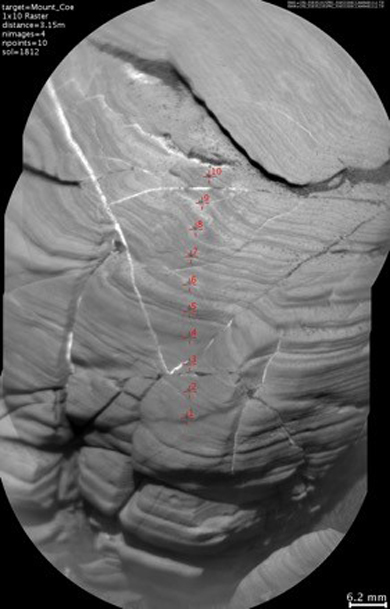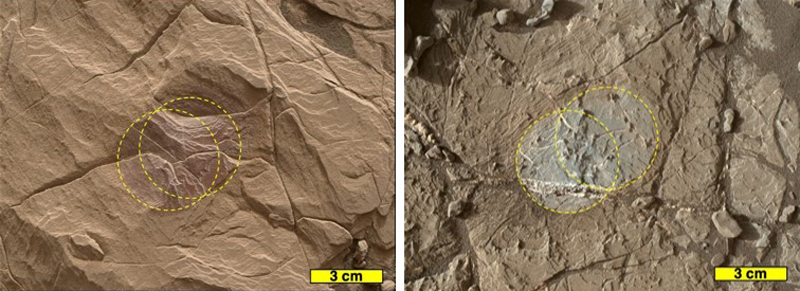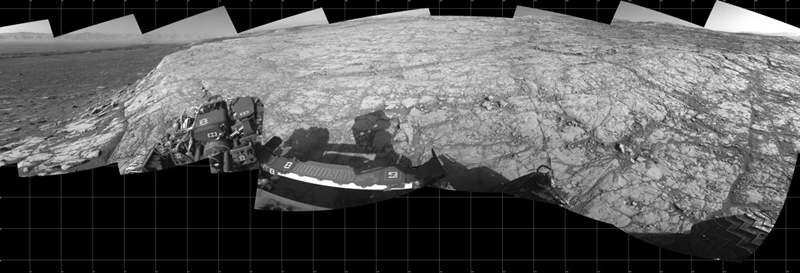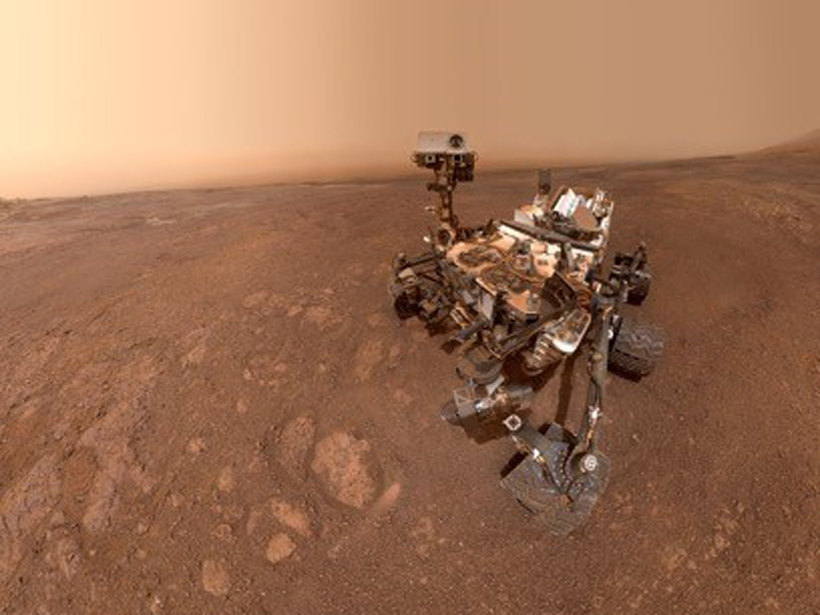It was the ultimate ground truth. Standing out for its unique spectral characteristics from orbit, Vera Rubin ridge (VRR) is located near the base of Mount Sharp in Gale crater, Mars. This 200-meter wide and 6½ kilometer long ridge was the primary subject of investigation by the Curiosity rover for more than an Earth year. Through a carefully coordinated science campaign, the rover used a combination of imaging, spectral remote sensing, contact science, and drilled sample analysis to understand the origin of VRR and its distinctive characteristics.
A new special issue in JGR: Planets describes the findings from the VRR campaign, and details clear evidence for multiple episodes of aqueous activity at Gale crater, including later groundwaters that helped to form VRR. We asked science campaign leader Dr. Abigail Fraeman about the major findings at VRR and about the potential implications for ancient habitable environments at Gale crater.
Why was Vera Rubin ridge (VRR) of interest to the science team, prior to arrival?
The Curiosity Mars rover is studying the habitability of ancient Mars. Curiosity’s landing site, Mount Sharp, is an ideal place to do this because the strata that make up the approximately five-kilometer tall mound preserve a record of Mars’ changing ancient environments that the rover can access.
One of the key environmental markers identified prior to landing was a prominent ridge near the base of Mount Sharp. Orbital spectral data showed hematite, an iron oxide mineral, was present in the ridge. This discovery excited the team because it suggested the ridge might preserve a site where iron oxidation occurred in the past. On Earth, iron oxidation/reduction at redox interfaces is often catalyzed by microbes, and therefore the ridge was a prime location to explore habitability.

How did Vera Rubin ridge get its name?
In practice with naming key regions Curiosity explores after famous scientists, the Curiosity science team informally named the ridge “Vera Rubin ridge” (VRR) in honor of the pioneering American astronomer Vera Cooper Rubin (1928–2016). Dr. Rubin’s precise measurements of the rotation rates of galaxies revealed the existence of dark matter. She was also a fierce advocate for the equal treatment of women in science.

What were some of the hypotheses about VRR’s geologic history, prior to the investigations with the Curiosity rover?
Based on similar orientation of the ridge’s strata and the rest of Mount Sharp in orbital data, we hypothesized that the rocks in VRR formed during the same time Mount Sharp was being built. We also hypothesized that VRR’s high relief relative to its surroundings was due to change grain size or increased cementation.
As for the strong hematite signal, we initially thought VRR was a uniquely hematite-bearing interval, and proposed that the hematite formed either when iron-bearing, oxygen-poor fluids encountered an oxidizing environment and precipitated insoluble iron-bearing minerals, or by localized in-place oxidative weathering of other minerals.
However, we began to question these hypotheses when Curiosity’s instruments found hematite in the several hundred meters of strata below VRR. New questions emerged, such as How does the hematite in VRR relate to units stratigraphically below? and Why is the spectral signature of hematite so strong at VRR in orbital data?
What were the major findings regarding the origin and geologic history of VRR? What was the biggest surprise to the science team?

We found that most rocks in the ridge were fine grained with parallel bedding, and they were lain down in an ancient lake, just as were most of the strata below the ridge.
Hematite was present in the ridge as predicted from orbit, but somewhat surprisingly, there wasn’t significantly more hematite in the ridge than the strata below.
We discovered the strong hematite spectral signature seen from orbit along VRR was due in part to less sand and dust obscuring the ridge, but mostly because small changes in the hematite mineral grain size deepened the hematite spectral absorptions in the bedrock.
Another surprising finding was isolated “patches” of gray bedrock that were almost identical in composition to the red bedrock that made up the majority of VRR.
The team concluded the rocks were gray because they had “gray hematite,” which has larger mineral grain sizes than red hematite. The gray patches cross-cut primary bedding, so they formed sometime after the strata on the ridge were laid down. On Earth, gray hematite is most commonly found in hydrothermal settings, so its presence on the top of the ridge is puzzling.

Overall, the data Curiosity collected at VRR suggest that the ridge formed from late-stage fluids that hardened and recrystallized a band of pre-existing rocks in Mount Sharp. These rocks later became a ridge as millions or even billions of years of wind erosion worked to lower the level of the softer rocks on either side of VRR.
How did the VRR findings change the current framework of understanding for the geologic history of Mt. Sharp and/or habitability of Gale crater in general?
VRR is a new example of how groundwater shaped the Martian rock record on a scale that is visible from orbit. The finding that the rocks in the ridge were initially deposited in a lake, similar to the approximately 300 meters of strata below the ridge, demonstrates that these environments persisted for a very long time, likely tens of millions of years.
While VRR does not represent a redox interface that would have marked a new kind of habitable environment, the evidence for at least one, and more likely multiple, late-stage interactions with fluids at VRR further expands the period of time when liquid waters would have been present at Gale crater, likely in the shallow or deep subsurface. The presence of coarse-grained gray hematite on the ridge top might indicate waters were warm and/or long-lived, which could have provided favorable environments in the shallow subsurface sheltered from surface radiation and temperature variations. Combined, these results suggest habitable environments may have been preserved late into the Hesperian, first at the surface and later in the subsurface.

As the Curiosity rover continues its traverse of Mt. Sharp, what are the lessons learned from the VRR investigation that may be applied to future investigations?
Curiosity’s exploration of VRR adds to a list of examples that demonstrate the power of coordinated orbital and rover investigations for Mars exploration. Curiosity confirmed the orbital detection of hematite at VRR, but wheels on the ground were needed to reveal the full geologic context of this detection and provide critical clues to unravel the ridge’s history.
—A. Deanne Rogers, Editor, JGR: Planets; Mariek Schmid, Associate Editor, JGR: Planets; and Abigail Fraeman ([email protected]; ![]() 0000-0003-4017-5158), NASA Jet Propulsion Laboratory
0000-0003-4017-5158), NASA Jet Propulsion Laboratory
Citation:
Rogers, A. D.,Schmidt, M., and Fraeman, A. (2020), Curiosity solves the mystery of Gale Crater’s hematite ridge, Eos, 101, https://doi.org/10.1029/2020EO145629. Published on 31 July 2020.
Text © 2020. The authors. CC BY-NC-ND 3.0
Except where otherwise noted, images are subject to copyright. Any reuse without express permission from the copyright owner is prohibited.

